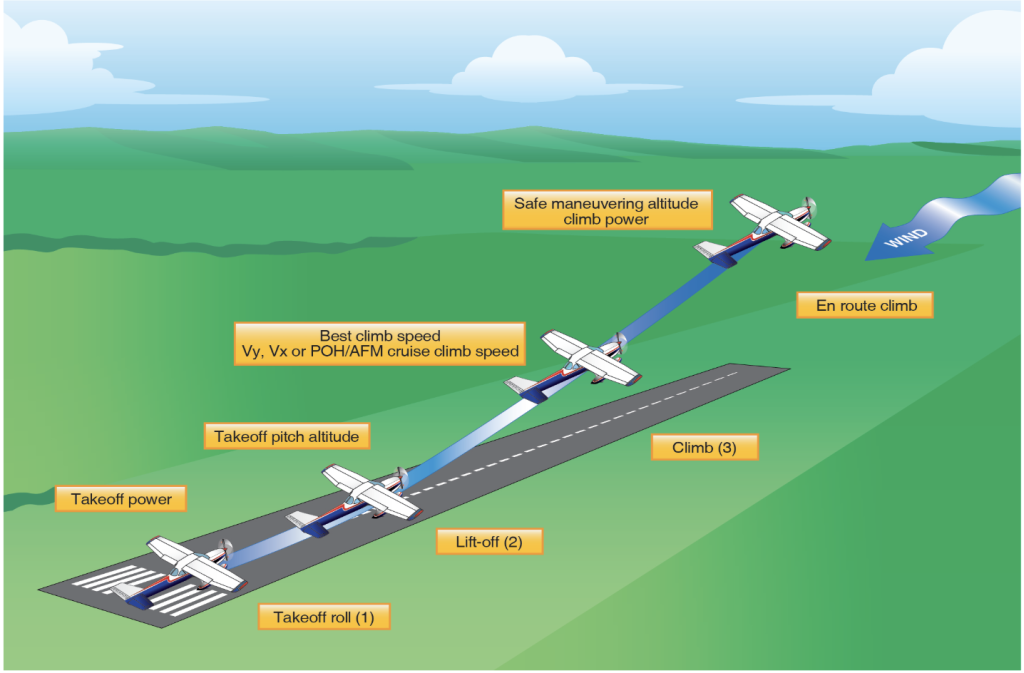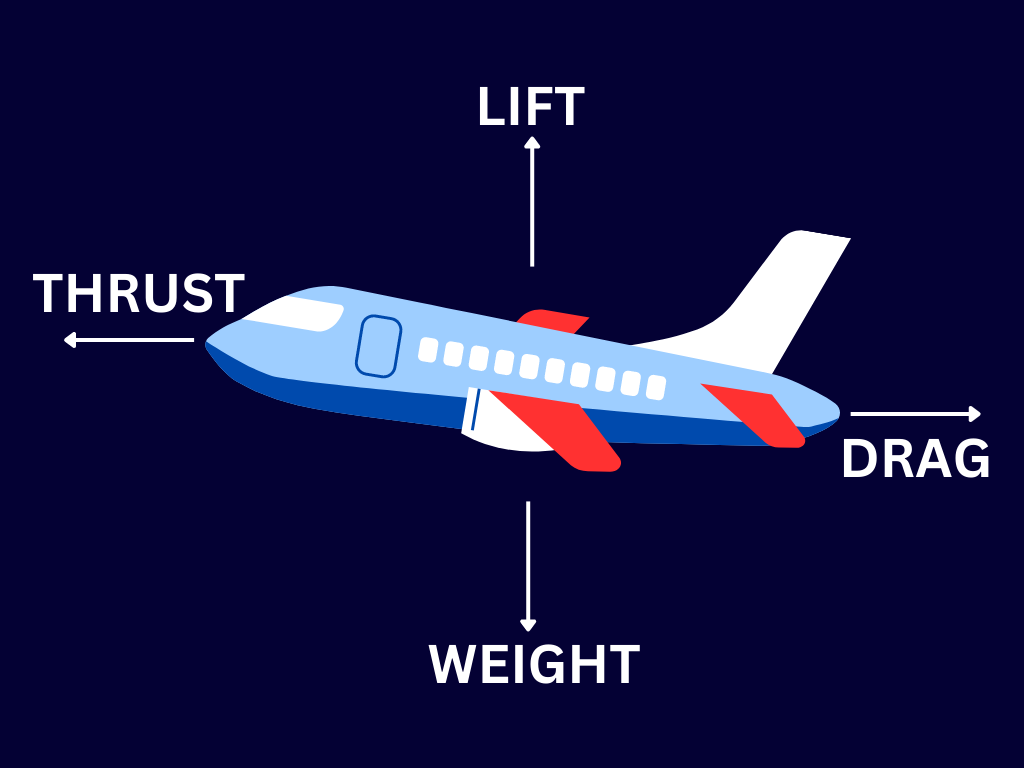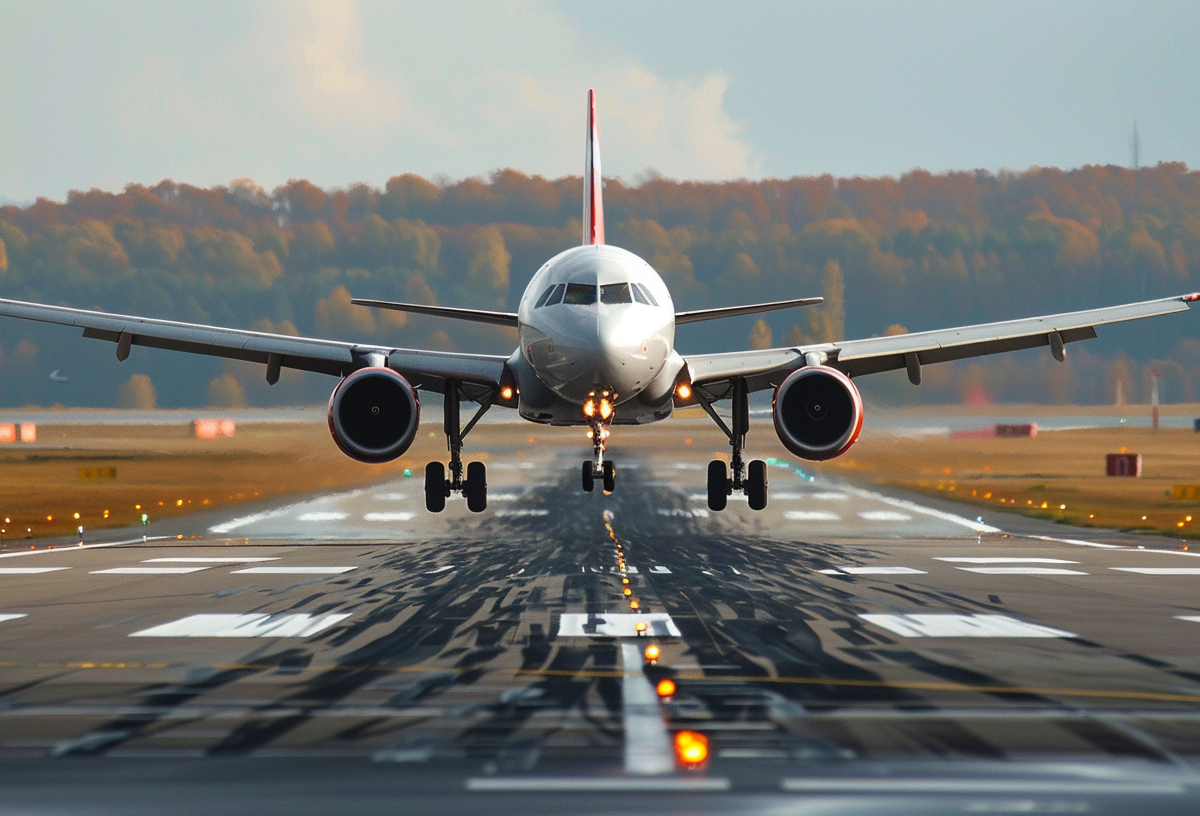Have you ever wondered how planes lift off the ground and soar through the sky?
The science behind aircraft takeoff is fascinating but can seem complex to the average person.
However, understanding the key principles is easier than you might think.
In this blog post, we’ll break down the essential elements that enable planes to take flight, from the forces at play to the critical role of the wings and engines.
We’ll explore how pilots control the aircraft during takeoff and discuss the different stages of the process.
By the end of this article, you’ll have a solid grasp of the scientific concepts behind aircraft takeoff, allowing you to appreciate the marvel of flight even more.
Let’s dive in and uncover the secrets of this incredible feat of engineering.
The Takeoff Process of An Airplane

The takeoff process is a carefully orchestrated sequence of events that begins when the aircraft taxis onto the runway and ends when it becomes airborne.
Adherence to procedures is essential to ensuring the safety of the aircraft, its passengers, and the airport personnel.
Various airport and aircraft systems work harmoniously to facilitate a smooth takeoff, including ground control, navigation aids, and automated systems that monitor and adjust the aircraft’s performance.
1. Taxiing
Before takeoff, the aircraft must taxi to the appropriate runway.
During this phase, the pilots communicate constantly with the air traffic control tower and follow instructions to navigate the airport’s taxiways safely.
The aircraft’s taxi lights are turned on to increase visibility, and the pilots perform final mechanical checks to ensure all systems are functioning properly.
2. IncreasingThrust
As the aircraft aligns with the runway, the pilots carefully adjust the engine settings based on the aircraft’s weight, prevailing weather conditions, and runway length.
This process requires precise calculations to ensure the engines generate the optimal amount of thrust for a safe and efficient takeoff.
3. Gaining
The pilots release the brakes once the engines are set, and the aircraft accelerates down the runway.
Depending on the aircraft type and weight, planes typically need to reach speeds ranging from 130 to 180 miles per hour (about 209 to 290 kilometers per hour) to achieve lift-off.
The plane must reach this specific velocity, the rotation speed, to generate sufficient lift for takeoff.
The texture and condition of the runway surface can significantly impact the aircraft’s acceleration.
Smoother surfaces generally allow for faster acceleration and shorter takeoff distances.
How Airplane Overcome Air Resistance?

As the aircraft gains speed, its aerodynamic design helps minimize air resistance.
Features like the streamlined fuselage, swept wings, and smooth surfaces work together to reduce drag and improve overall efficiency.
Pilots closely monitor various speed indicators and other instruments that provide real-time data on the aircraft’s performance.
This information allows them to adjust the aircraft’s pitch, power settings, and control surfaces to maintain optimal speed and control during the takeoff roll.
1. The Role of Wings During Takeoff
Wing design plays a crucial role in an aircraft’s takeoff performance.
Key aspects of wing design include the aspect ratio (the wingspan relative to the wing’s chord), wing loading (the aircraft’s weight divided by the wing area), and high-lift devices such as slats and flaps.
- During takeoff, these high-lift devices are extended to increase the wing’s surface area and curvature, generating more lift at lower speeds.
- Different wing configurations, such as swept or delta wings, offer unique advantages and disadvantages during the takeoff phase, depending on the aircraft’s intended purpose and operating conditions.
2. Airflow Management Over Wings
As the aircraft accelerates down the runway, the wings interact with the oncoming air in a complex manner.
The shape of the wing, particularly its curvature and angle of attack, determines how the air flows over and under the wing surfaces.
Laminar flow, characterized by smooth, parallel airflow, is desirable for reducing drag and improving efficiency.
However, as the angle of attack increases during takeoff, the airflow can become turbulent, creating a boundary layer that can potentially separate from the wing surface and lead to a loss of lift.
To manage these airflow characteristics, pilots adjust the wing’s flaps and slats to optimize lift generation while minimizing drag.
3. Critical Moments in Wing Functionality
- One of the most critical moments during takeoff occurs when the pilot initiates rotation, which involves raising the nose of the aircraft to increase the angle of attack.
- This action causes a sudden change in the airflow over the wings, leading to a significant increase in lift.
- As the aircraft leaves the ground, the wings continue to generate lift, but the focus shifts from maximizing lift to reducing drag and improving aerodynamic efficiency.
- This transition from the takeoff roll to the initial climb phase requires precise control inputs from the pilots to ensure a smooth and safe ascent.
Fundamental Principles of Flight

To grasp how planes take off, it’s essential to understand the four primary forces that govern an aircraft’s flight: lift, weight, drag, and thrust.
These forces work together in an intricate balance, each playing a crucial role in achieving a successful takeoff, maintaining steady flight, and executing a safe landing.
The interaction between these forces determines an aircraft’s trajectory and overall performance.
1. Lift
- The shape of an airplane’s wings, known as the airfoil, is designed to create a difference in air pressure above and below the wing.
- As the plane moves forward, the air moving over the curved upper surface speeds up, reducing pressure, while the air beneath the flatter bottom surface maintains relatively higher pressure.
- This pressure difference generates lift, enabling the plane to ascend.
- The angle at which the wing meets the oncoming air, called the angle of attack, also significantly affects lift; small changes in this angle can greatly impact the aircraft’s ability to take off and climb.
2. Weight
- An aircraft’s weight is determined by its structure, fuel, cargo, and passengers.
- Engineers meticulously design planes to minimize unnecessary weight while ensuring structural integrity.
- Weight distribution is also carefully considered to maintain balance and stability during flight.
- As the plane burns fuel, its weight decreases, affecting the overall flight dynamics.
3. Drag
- As a plane moves through the air, it encounters resistance, known as drag.
- There are two main types of drag: parasitic and induced.
- Parasitic drag arises from factors like air friction on the plane’s surfaces and the shape of non-wing components.
- Induced drag is a byproduct of the same pressure difference that creates lift.
- To counteract drag, aircraft designers strive to create sleek, aerodynamic shapes and employ features like winglets to improve efficiency.
4. Thrust
- Engines, either jet engines or propellers powered by combustion engines, generate the forward force called thrust.
- The engine creates an equal and opposite reaction by rapidly pushing air backward, propelling the plane forward.
- The amount of thrust required varies based on factors like the aircraft’s size, weight, speed, and environmental conditions.
Role of Air and Air Pressure
Air density, affected by factors like temperature, humidity, and altitude, plays a significant role in an aircraft’s performance.
- Higher air density generally enhances engine performance and wing lift, while lower density can negatively impact these characteristics.
- Pilots and onboard systems continually monitor and adjust to changing atmospheric conditions to maintain optimal performance.
For example, on hot days or at high altitudes where the air is thinner, planes may require longer runways to achieve sufficient speed for takeoff.
Turbochargers and superchargers can also compensate for lower air density by compressing the air entering the engine, maintaining performance in challenging conditions.
Different Flight Speeds of Each Regime
| Flight Regime | Characteristics | Engineering Solutions | Thrust-to-Weight Ratio Considerations |
|---|---|---|---|
| Subsonic |
– Streamlined designs to minimize drag. – Wings are wider and thicker to generate sufficient lift at lower speeds. |
– Optimized airfoil shapes for efficiency. – Focus on fuel efficiency through aerodynamic designs. |
– Lower thrust-to-weight ratios. – Prioritizes fuel efficiency and payload capacity. |
| Transonic |
– Encounter compressibility effects near the speed of sound. – Localized shock waves can form on wings and control surfaces. |
– Use of wing sweep and supercritical airfoils to minimize shock wave effects. – Design modifications to maintain control. |
– Moderate thrust-to-weight ratios. – Balances efficiency and performance capabilities. |
| Supersonic |
– Formation of shock waves that increase drag and can cause stability issues. – Requires more power to maintain speed. |
– Thin, swept wings to reduce drag. – Specialized control surfaces and more powerful engines. |
– High thrust-to-weight ratios. – Designed for rapid climbs and aggressive maneuvers. |
| Hypersonic |
– Speeds above Mach 5 lead to significant aerodynamic heating – Experimental phase with intense heat due to air compression. |
– Use of advanced materials like ceramic composites and heat-resistant alloys. – Development of unique propulsion systems like scramjets. |
– Extremely high thrust-to-weight ratios. – Focus on overcoming extreme aerodynamic heating and maintaining structural integrity. |
Each flight regime presents unique challenges and requires specific engineering solutions:
1. Subsonic
Aircraft in this regime typically have streamlined designs to minimize drag and optimize fuel efficiency.
The wings are often wider and thicker to generate sufficient lift at lower speeds.
2. Transonic
As aircraft approach the speed of sound, they encounter compressibility effects, which can lead to the formation of localized shock waves on the wings and control surfaces.
Designers use wing sweep and supercritical airfoils to minimize these effects and maintain control.
3. Supersonic
Supersonic flight is characterized by the formation of shock waves that create a sudden increase in drag and can cause stability issues.
To overcome these challenges, aircraft designed for supersonic flight often feature thin, swept wings and specialized control surfaces.
They also require more powerful engines to maintain speed and overcome the increased drag.
4. Hypersonic
- Hypersonic flight, which is still largely experimental, involves speeds above Mach 5.
- At these extreme speeds, aerodynamic heating becomes a significant concern, as air compression around the aircraft generates intense heat.
- Advanced materials, such as ceramic composites and heat-resistant alloys, must withstand these conditions.
- Unique propulsion systems, like scramjets (supersonic combustion ramjets), are being developed to enable sustained hypersonic flight.
Overcoming Gravitational Forces for Taking Off
One of the primary challenges in aircraft design and operation is overcoming the Earth’s gravitational pull.
This process requires a combination of sufficient thrust and lift, which is quantified by the thrust-to-weight ratio.
Aircraft designed for high-performance roles, such as fighter jets and rockets, typically have high thrust-to-weight ratios, allowing them to climb rapidly and maneuver aggressively.
In contrast, commercial airliners and cargo planes have lower thrust-to-weight ratios, as they prioritize fuel efficiency and payload capacity over raw performance.
Designers must carefully balance these factors to ensure that the aircraft can generate enough lift to overcome its weight during all phases of flight, from takeoff to landing.
Pilot’s Role and Cockpit Controls in Takeoff
Pilots play a critical role in ensuring a safe and successful takeoff.
Before the aircraft leaves the gate, pilots must complete a comprehensive pre-flight checklist, which includes verifying the functionality of all systems, checking weather conditions, and ensuring the aircraft is properly balanced and loaded.
Once the aircraft is ready for takeoff, pilots must communicate with air traffic control to obtain clearance and coordinate with other nearby traffic.
During the actual takeoff roll, pilots must closely monitor the aircraft’s speed, engine performance, and directional control, making adjustments as necessary to maintain a safe and stable climb.
1. Using Cockpit Instruments and Controls
Modern aircraft cockpits are equipped with various instruments and controls that assist pilots in managing the different aspects of flight.
The primary flight controls include the yoke (or control stick), which controls pitch and roll; the throttles, which regulate engine power; and the rudder pedals, which control yaw.
In addition to these manual controls, most modern aircraft also feature automated systems that help maintain stable flight, manage engine performance, and navigate complex airspace.
Pilots must be thoroughly trained in using these systems and understand when to rely on automation and when to use manual control.
2. Real-Time Adjustments and Decision Making
Despite careful planning and preparation, unexpected situations can arise during takeoff that require pilots to think quickly and take decisive action.
- These scenarios can include engine failures, sudden changes in weather conditions, or system malfunctions.
- In such cases, pilots must rely on their training and experience to assess the situation and determine the most appropriate action.
- This may involve aborting the takeoff, adjusting the aircraft’s configuration, or declaring an emergency and coordinating with air traffic control for assistance.
Regular simulator training helps pilots develop the skills and confidence needed to handle these high-pressure situations effectively, ensuring the aircraft’s and its occupants’ safety.
Final Words
In conclusion, the science behind aircraft takeoff is a fascinating blend of physics, aerodynamics, and skilled piloting.
By understanding the fundamental principles of flight, the intricate takeoff process, and the critical role of wings, we can better appreciate the incredible feat that occurs every time a plane lifts off the ground.
From the moment the engines roar to life until the aircraft soars into the sky, a complex interplay of forces and controls work together to ensure a safe and efficient takeoff.
As technology advances, pushing the boundaries of flight into ever more impressive regimes, the role of pilots and their mastery of cockpit controls remains essential.
The next time you witness an aircraft taking flight, take a moment to marvel at the science and skill that make it all possible.






